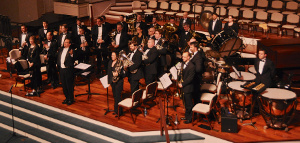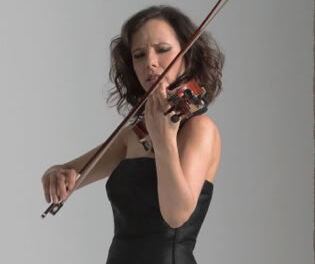With its four events in two days, the North Carolina Computer Music Festival broke new ground at NCSU, where its organizer, composer Rodney Waschka II, is based, and significantly enlarged the scope of Arts NOW’s offerings, too. Not since the heyday of Roger Hannay’s cutting-edge work at UNC have we experienced such a heavy dose of new music in such a short period of time here, in the Triangle. Eighteen pieces composed (or, perhaps more accurately, created) between 1994 and 2002 were presented in three concerts, and several more were heard during a fascinating series of afternoon lectures on the second day of the festival. Many of the composers were on hand to present and discuss their work. Remarkably, only one piece received its world premiere during the festival; this says much about the development and propagation of new music in our midst.
The festival began with a gala concert in Stewart Theatre on March 18. The living, breathing guest artist was F. Gerard Errante, a clarinetist Waschka said is as adept in Mozart as in new music, but who prefers the latter. (It is therefore curious to note that there was, concurrently with the NCCMF, a North Carolina Mozart Festival, elsewhere in the capital, on the same evenings, portions of which are reviewed elsewhere in this issue.) Errante was suffering from a cold but this did not seem to impede his playing in the slightest. He offered music by Peter Terry, Judith Shatin, Mike Frengel, Robert Scott Thompson, Reynold Weidenaar and himself that involved variously described computer music (recorded or generated in real time, we are guessing) with more or less live clarinet sounds, sometimes altered and/or enhanced electronically. Several of the composers will be familiar to our regular readers: Judith Shatin’s music has been performed at Duke by the Ciompi Quartet, and others, whose works were given on other occasions, are known entities. All the works given on this occasion bore titles that were-more or less-descriptive of the music: Captured Light, Sea of Reeds, Silent Tears, etc.
As it happens, Shatin’s Sea of Reeds was one of the most engaging works heard during the festival. The electronics were deftly managed, and Errante’s extension (literally) of his instrument was amazing to witness and hear, too. The reeds were represented by two lengths of PVC pipe–a 1/2″ section slipped into a companion piece of 3/4″ tubing. The whole thing was then shoved into the clarinet’s bell and manipulated like a slide trombone–but with the feet, due to the length of the extension. Needless to say, some strange and unusual sounds resulted–and still more came on those occasions when Errante blew at the mouthpiece from several inches away. Some of the effects thus produced would have been inaudible without amplification, but that, too, was provided–at no extra charge, someone noted!
Errante demonstrated his consummate artistry and understanding throughout the evening, bringing the various works to vibrant life in a way that did not routinely happen with some of the purely “canned” things heard on other occasions. The opening and closing works on the program were music videos, for want of a better term. In both cases–and later in the festival, too–the music was much more advanced than the visual images, but in all cases there was clear integration of pictures and sound, so the works were “of a piece.”
The clarinetist got a break a third of the way through when the festival’s senior composer, the distinguished Larry Austin (who was making his second appearance at NCSU), presented his restoration and expansion of a major score by John Cage, titled (in the revision), Williams [re]Mix[ed]. Austin has a huge reputation in the music business because of his many contributions and innovations. Among his accomplishments is a completion of Ives’ “Universe” Symphony. It is curious that he was represented on this occasion by another of his quasi-restorations–it is only his second such undertaking, he told us–rather than one of his purely original works. It fit the mix of the festival, however, and during his lecture the next day, he explained how he’d done it and with what computer equipment. Williams [re]Mix[ed] is an octophonic piece, and Austin’s elaborations and expansions, done with a computer program he himself developed, seemed to grow seamlessly from the original portion, laboriously assembled by Cage and his colleagues over a period of some nine months. We asked Austin if computers make it all too easy to do this sort of thing now. He responded that it’s hardly “easy”–it took him over eleven months to write the program that he used to restore the Cage!
The lectures, presented before a small crowd of mostly young people the next afternoon, included Austin’s revealing discussion and demonstration (he actually had the machine generate a new bit of music–80 or so seconds’ worth–as we watched) plus an informative talk by composer Howard Fredrics on “Crosscurrents in Popular and Experimental Music” that reminded us of how much innovation has come over from the pop world–starting with the Theremin and Alvin and the Chipmunks and moving (quickly) to the Beatles and Jimi Hendrix. Last but hardly least, composer Martin Fumarola, who won the prize for long-distance travel (he came all the way from Argentina), gave an update on recent trends, using CDs of various new works, including his own “Argos” (which, written in 1988, was far and away the oldest thing heard during the entire festival).
The Tuesday afternoon concert consisted of recorded music with two videos. The creators were Elainie Lillios, Douglas Geers and Christine Sciulli, Beatriz Ferreyra, John Villec, and Michael Thompson, and these works were, like the others, cleverly titled. Some seemed overly long–another indication, if one were needed, that the pieces with live performers were, by and large, more successful than the canned ones. That said, some were quite powerful and moving, and among the best was Thompson’s Machinewerks, which suggested (to this listener, at least) Mossolov’s Iron Foundry.
The grand finale brought forth music by Benjamin Broening ( Nocturne/Doubles, the event’s only world premiere), Anna Rubin and Laurie Hollander, Frances White, Fredrics, John Young, and Eric Lyon. Two of these (the second and fifth items, respectively) were pure recorded computer music, but the rest involved various live performers–Broening’s pianism, NCS violist David Marschall in White’s stunning (and stunningly beautiful) “a veil barely seen,” mezzo-soprano Lori Joachim Fredrics in her other half’s moving setting of a Swedish poem, and pianist David Koppelman in Lyon’s Psychic Driving. The performances were at very high levels, and technical glitches were few, although there were several false starts here and there and one senses that the last work was not heard in its intended form, due to some malfunction. No matter. Without scores, how could one know?
After each event, the many composers were eager to engage audience members in discussions. The exhaustive program notes were in some cases more extensive than the scores they described but were–and are–worth their weight in gold. This was a class act from start to finish, including the spoken introductions and the richly varied performances themselves. These works are viable things, not the products of kooks, and they are all recognizable as music, even if that music is not like the everyday garden variety. There’s music in them thar PCs, and the folks who took part in this outstanding festival are helping unlock it and sharing it with ever-larger audiences. The rest of us need to get on board before we miss the train–or the doppler, at the very least.
It would be churlish of me not to praise the organizational skills of Rodney Waschka II, without whose planning and stick-to-it-iveness this festival would not have happened. That it happened at all – and at what we used to call “Cow College,” too – is nothing short of amazing. Bravo!












